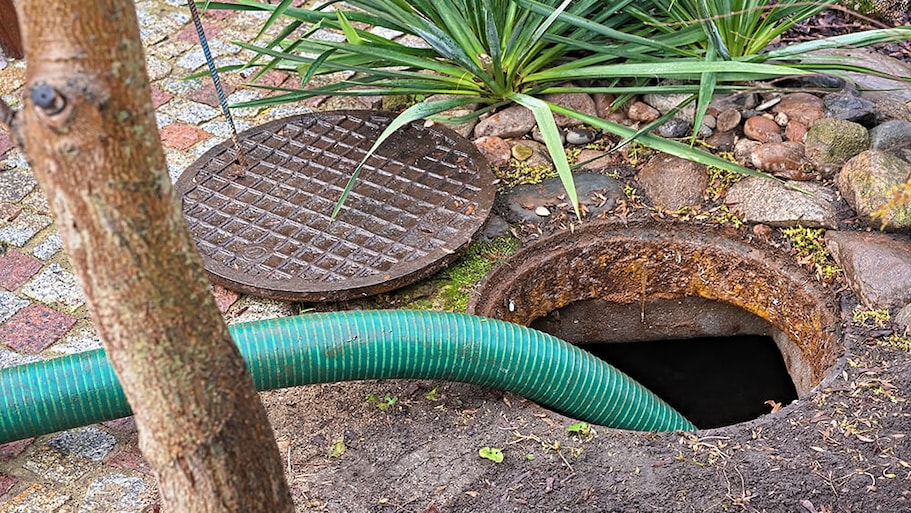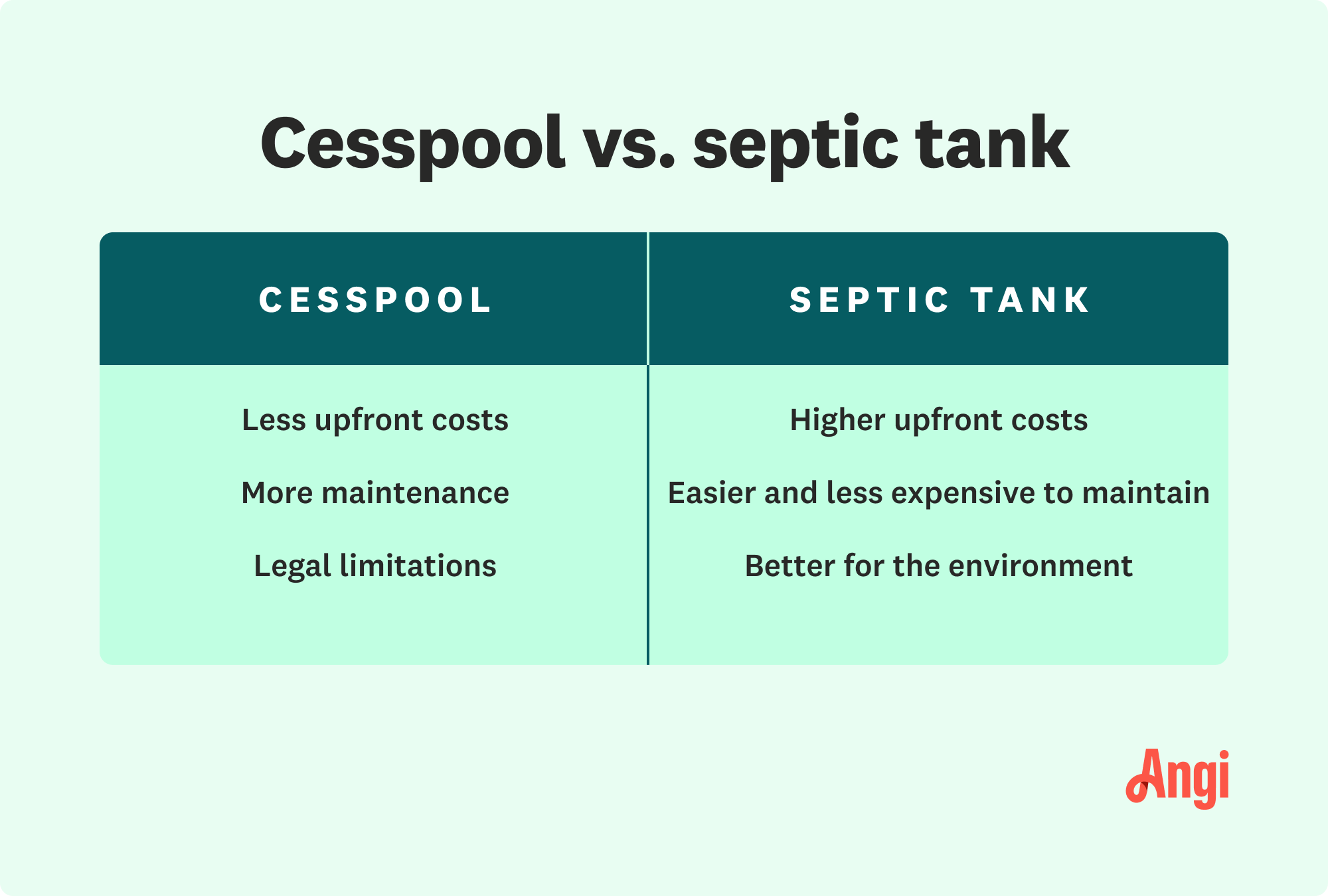
Caring for your septic system is crucial to ensuring its long life. But how much does it cost to pump a septic tank? We explore the different cost factors.
Don’t waste time and money installing the wrong waste management system


Cesspools are simply holding tanks for wastewater, but septic tanks are part of a septic system, which treats wastewater.
Cesspools cost $6,500 to $8,000 on average, while septic systems can cost up to $24,000, but you’ll spend a lot less over time on septic tank maintenance.
Cesspools have many legal limitations across the country.
Septic tanks are a better choice for most homeowners.
When you live in a rural area or are looking to buy a new home, one thing you may have to consider is wastewater management. For city dwellers, the main sewer line on the property helps direct your wastewater to the city’s facilities. But in rural areas, you could have to install or maintain an existing cesspool or septic tank.
The cesspool and septic tank are two different systems that can impact your costs, ongoing maintenance, and even the environment around your property. So before you sign the line to buy your dream farmhouse or install a wastewater management system on your property, learn the differences, pros, and cons of a cesspool versus a septic tank.

The main difference between a cesspool versus a septic tank is that the septic tank will filter out the waste from the water, and it uses bacteria to break down the waste before it flows further through the system for more treatment. Eventually, the treated wastewater goes from the septic system to the soil.
A cesspool is simply a holding tank, so it doesn’t filter or treat the wastewater. Instead, the homeowner needs to hire a local cesspool cleaning service to empty the holding tank.

A cesspool, sometimes called a cesspit or holding tank, is a tank that holds wastewater but doesn’t filter or treat it. Instead, a professional cesspool cleaning service has to come at least every six weeks to remove the waste and properly dispose of it, or the cesspool can overflow (no one wants to deal with that, trust us).
Many municipalities and states have laws that limit cesspool installations for new constructions, and some laws require cesspools to be replaced with septic systems. The U.S. Environmental Protection Agency has banned large-capacity cesspools entirely, which are cesspools big enough to service more than one single-family home or buildings with more than 20 people.
| Cesspool Pros | Cesspool Cons |
|---|---|
| Good for rural properties | Needs regular emptying |
| Temporary option | Sometimes prohibited |
| Low upfront costs | High maintenance costs |
Best for:
Temporary wastewater management on construction sites
Homes with soil conditions that aren’t suitable for a septic system
Rural homes with not enough space for a tank and leach field
A cesspool can be useful in limited situations. For instance, a cesspool may work as a temporary wastewater management system on a property that is under construction.
A septic tank needs just the right soil for proper wastewater disposal because the wastewater is treated and then slowly released into the soil in an area called the leach field. So for rural properties with soil that is too wet or too compact, the soil may not be suited to support a septic system. Not only that, but smaller properties may not have enough space for both a tank and the leach field, which is where a cesspool can come in handy.
A cesspool costs about $6,500 and $8,000 to install, which is less than installing a septic tank, which can cost up to $22,500. But if you’re budgeting for wastewater management, you’ll want to keep ongoing maintenance costs in mind.
One major drawback to a cesspool is that your city, county, or state may ban cesspools entirely. That means you could buy a home with a cesspool but may need to replace it. Or, you may have crunched the numbers and decided a cesspool is a better fit to install at your new home, only to find you can’t install one after all.
Although cesspools have lower upfront costs compared to septic tanks, they also need to be emptied far more often, and those costs can really add up. You’ll need to hire a pro to clean the cesspool at least once every six weeks, totaling about $2,300 to $4,350 per year in maintenance.

Septic tanks are part of a septic system, which separates water and solid waste. The solid waste settles to the bottom of the septic tank as sludge, and the wastewater is treated and directed to the leach field, or drain field, where it will disperse into the soil and bacteria will further treat the wastewater.
According to the U.S. EPA, more than 20% of homes in the U.S. have a septic system. While they are common in rural areas, septic systems can also be found in suburban or even urban properties instead of a sewer main line.
| Septic Tank Pros | Septic Tank Cons |
|---|---|
| Good for rural or urban properties | Require specific soil conditions and space |
| Sustainable | Need pumped every 1 – 3 years |
| Low maintenance costs | High upfront costs |
Best for:
Rural and some urban or suburban areas
Homes with enough yard space to build a tank and leach field
Properties with loamy soil able to absorb filtered wastewater
While cesspools have a lot of restrictions, even in rural settings, septic tanks are more common. They work in rural areas but can also be found in cities or suburban areas for properties that aren’t connected to a municipal sewage system.
Septic tanks are better for the environment than cesspools when they are well-maintained. Cesspools need to be pumped frequently, or they can overflow. Septic tanks need to be pumped, usually every one to three years, but they can help naturally replenish groundwater supplies with treated wastewater in the leach field.
Because of the longer timespan between each septic tank pumping, you can save on the time and costs of maintenance compared to a cesspool. Septic tank pumping costs about $175 to $600, far less than the cost to clean a cesspool.
Because the septic system needs to release treated water into the drain field, the soil in this area needs to have the right balance of moisture and density to drain the water. If the soil is too wet or isn’t loamy, the property may need a cesspool instead.
The size of a septic tank system is also a factor to consider. Septic tanks are about 4.5 feet wide, 8 feet long, and 6 feet tall, and the drain field typically needs to be at least 100 square feet but can vary based on local laws.
Septic tanks require less maintenance than a cesspool, but they aren’t above needing a little TLC. The septic tank needs to be pumped about once every one to three years to prevent the sludge from building up and causing backups into your home’s plumbing.
The other downside to installing a septic tank is that the upfront cost is typically higher than the cost to install a cesspool. However, you can make up for these costs in the long run with lower maintenance costs.
Ultimately, choosing a cesspool versus a septic tank depends on your property, budget, and local laws. However, if you’re in a spot where both options are available to you, consider the following factors to help you make your decision.
A septic system costs more than a cesspool upfront, about $7,300 on average or up to $22,500. By comparison, a cesspool costs around $6,500 to $8,000. But cesspools are far more expensive to maintain, about $2,300 to $4,350 per year. Septic tanks cost about $175 to $600 per year for maintenance. Over a 20- to 40-year life span, a septic tank costs less in the long term.
While you need to leave installing any waste management system to the pros, installing a cesspool is typically easier. With a cesspool, the installers need to place the holding tank, while with a septic tank system, they need to install a tank and prepare the leach field.
Cesspools require far more maintenance than septic tanks. Because the cesspool doesn’t filter water and direct it away from the home, it can fill up quickly with untreated wastewater. To prevent this wastewater from backing up into the drains around your home, it has to be emptied far more often than a septic tank.
Both a septic tank and a cesspool can last up to 40 years with proper care. Of course, when you consider emptying the cesspool every six weeks for decades compared to pumping a septic tank every few years, you may be ready to switch to septic.
Septic tanks are a more sustainable alternative to cesspools because they can help replenish groundwater with filtered, treated wastewater. And when you consider the emissions associated with trucks coming to pump the septic tank once every year or so compared to every six weeks or more for a cesspool, septic tanks have a smaller carbon footprint.
Poorly maintained waste management systems of any kind can hurt your resale value, but even a well-maintained cesspool could lead to a lower property value when you want to sell. That’s because the new owners may be tasked with replacing the cesspool altogether based on local laws.
From average costs to expert advice, get all the answers you need to get your job done.

Caring for your septic system is crucial to ensuring its long life. But how much does it cost to pump a septic tank? We explore the different cost factors.

The average cost to connect to a public sewer line can vary depending on the linear foot, piping material, local regulations, and more.

Sewer cleanout costs depend on the type of cleanout and how long the line will be. Click here to start planning your budget for this project.

Got a septic tank? Then you've got a leach field. Knowing where it is helps you maintain your system. Here's how to find a leach field.

It can be unsettling when your sump pump smells like sewage, but it doesn’t always indicate a serious issue. Here are four potential causes and solutions.

Septic system upkeep is crucial, but it’s no easy task. Here’s how to install a septic tank riser to make accessing your tank faster and more efficient.